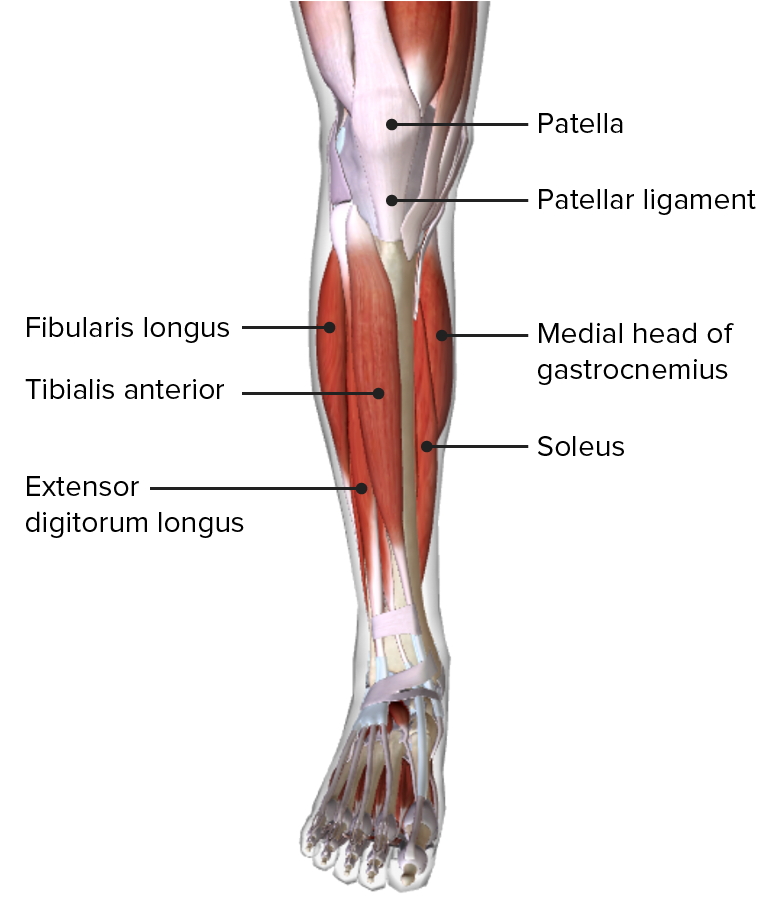Playlist
Show Playlist
Hide Playlist
Introduction – Anatomy of the Leg
-
Slides 06 Lower Limb Anatomy.pdf
-
Download Lecture Overview
00:01 In this lecture, we’re going to look at the leg. So we’ll start off by looking at the leg in cross-section and returning to the deep fascia and the various intermuscular septae. 00:14 We’ll then look at the various muscles within each of the three compartments. 00:18 So we’ll look at the muscles in the anterior compartments, and their function and innervation. 00:22 We’ll then look at the muscles in the lateral compartment, their function and innervation. 00:27 And then finally, we’ll look at the muscles within the posterior compartment and detail their function and innervation as well. First of all, let’s return to a familiar view which is of a cross-section of the lower limb, and this time, we have got a section through the leg. We have the anterior surface here, and we have the lateral surface here, and the medial surface and the posterior surface. Remember, we’re looking at this from the inferior view. So within the subcutaneous tissue, we find the great saphenous vein and the small saphenous vein. Remember those from the previous lectures. And then we can see we’ve got our two bones within the leg. We have the tibia which is positioned more medially, and actually, we can see here, it runs very superficial. The sharp anterior aspect of the tibia can be palpated through the skin. Then we have the fibula, a much smaller bone that is more important with providing surface area for muscle attachments. So what we can see with this transverse section is that we have three compartments, and these three compartments are formed by the interosseous membrane which we can see running between the tibia and the fibula. 01:47 And then we have the anterior intermuscular septum we can see here. And we’ve got a posterior intermuscular septum which we can see here. These two septae and the interosseous membrane are separating the leg into an anterior compartment, a lateral compartment, and a very substantial posterior compartment. Within here, we can see the number of muscles which we’re going to go on a detail. We can also see some important blood vessels. 02:18 We’ve got the tibial nerve here. We’ve got the anterior tibial arch we can see here, and the deep fibular nerve, which we’ll cover during this lecture. So we have those three compartments that have been created by the various septae and the interosseous membrane. 02:37 And within the anterior compartment, we have muscles which were associated with extension and dorsiflexion. Within the lateral compartment, we have muscles which are primarily associated with eversion. And in the posterior compartment, we have muscles associated with flexion and plantar flexion. The posterior compartment itself is divided into superficial and deep layers. And we’ll see this as we group the muscles separately. This is done via a transverse intermuscular septum, which we can see running along in this direction. And that separates these muscles which we can see here; flexor hallucis longus, tibialis posterior, and flexor digitorum longus from the most superficial muscles being gastrocnemius and soleus. 03:27 So this transverse intermuscular septum separates the posterior compartment into two layers.
About the Lecture
The lecture Introduction – Anatomy of the Leg by James Pickering, PhD is from the course Lower Limb Anatomy [Archive].
Included Quiz Questions
Which movement is performed by the group of muscles located in the lateral compartment of the leg?
- Eversion
- Flexion
- Plantar flexion
- Dorsiflexion
- Extension
Which structure is present in the anterior compartment of the leg?
- Fibularis tertius
- Popliteus
- Fibularis longus
- Fibularis brevis
- Soleus
Customer reviews
5,0 of 5 stars
| 5 Stars |
|
5 |
| 4 Stars |
|
0 |
| 3 Stars |
|
0 |
| 2 Stars |
|
0 |
| 1 Star |
|
0 |




